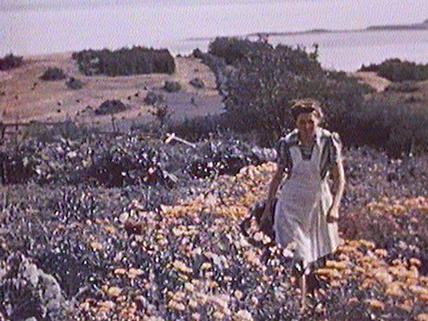 |
|||||
|
|
|
|
|
|
|
 |
|||||
|
|
|
|
|
|
|
| Réalisé par Jane Marsh |
| Canada, 1943 (documentaire, 37 minutes, couleurs, anglais) |
|
Autre |

|
| Image : © Office national du film du Canada |
|
Description du film : « Document ethnographique d'importance sur la culture canadienne-française en milieu rural pendant les années 1940. On y montre les pratiques religieuses, la fabrication du savon, l'utilisation des outils de la ferme, du four à pain, des voitures à chevaux, des métiers à tisser, etc. Bref, il nous rappelle un temps aujourd'hui révolu où le dur labeur de la terre n'altérait pas pour autant la joie de la vie à la campagne. Ce film d'archives tout à fait exceptionnel a été tourné en 1943 aux Éboulements, dans le comté de Charlevoix, sur la ferme d'une famille Bouchard. » -- Office national du film du Canada (source) |
| Générique (partiel) : | |
| Scénario : | Jane Marsh |
| Montage images : | Jane Marsh |
| Musique : | Louis Applebaum, Maurice Blackburn |
| Société de production : | National Film Board of Canada / Office national du film du Canada |
| Générique additionnel : | Camera [photographie]: Judith Crawley |
« For years (until it was withdrawn from circulation in 1960), [Alexis Tremblay: Habitant] was one of the NFB's most popular films. If one can now easily condemn its ideologically reassuring image of happy peasants secure in the bosom of their faith, it is also necessary to consider its context. It reflects precisely an image propounded at the time by Quebec society itself, most significantly by the Church. But beyond this, it is a striking example of a continuing current in Canadian documentary: the romantic idyll of life on the land, where the innocence and peace of childhood remain undisturbed as humanity lives in harmonious relation with nature. »
-- Canadian Film Encyclopedia
(source)
« [Alexis Tremblay, Habitant] was another pastoral celebration—of the North Shore in Charlevoix county—an example of the 'picturesque' approach the French Unit film-makers would reject two decades later as the outsider's view. »
-- David Clandfield
(source)
« This film [Alexis Tremblay: Habitant] was constructed around the cyclical patterns of rural life dictated by the seasons, and the omnipresent St Lawrence gave the film an almost classic literary characterization. »
-- Gary Evans
(source)
« Alexis Tremblay: Habitant was a great success and the [National Film Board of Canada] was invited to present a special screening to the Quebec Legislative Assembly. After the screening, [John] Grierson was supposed to present the filmmaker to the audience. Jane Marsh recalled, however, that Grierson became so involved in his own speech that he completely forgot she was there. »
-- Mary Teresa Nash
(source)
« Jane Marsh shot Alexis Tremblay: Habitant with Judith Crawley on camera. Originally, Jane Marsh had a disinterested cameraman shooting the film and said that 'every time I wanted to shoot something, he was over there doing other things...' When she replaced him with Judith Crawley, she said that 'the whole thing came into focus... it just sparkles because she's so good.' »
-- Mary Teresa Nash
(source)
|
|
|
|
|
|
|